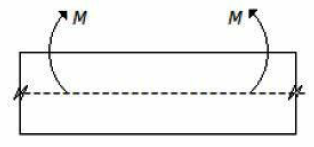The change of entropy, when heat is absorbed by the gas, is
Positive
Negative
Positive or negative
None of these
Correct Answer :
A. Positive
Related Questions
In the torsion equation T/J = τ/r = Gθ/ L, the term J/R is called
Shear modulus
Section modulus
Polar modulus
None of these
When a gas is heated at constant pressure
Its temperature will increase
Its volume will increase
Both temperature and volume will increase
Neither temperature not volume will increase
The increase in entropy of a system represents
Increase in availability of energy
Increase in temperature
Decrease in pressure
Degradation of energy
When a body is subjected to biaxial stress i.e. direct stresses (σx) and (σy) in two mutually perpendicular planes accompanied by a simple shear stress (τxy), then minimum normal stress is
(σx + σy)/2 + (1/2) × √[(σx - σy)² + 4 τ²xy]
(σx + σy)/2 - (1/2) × √[(σx - σy)² + 4 τ²xy]
(σx - σy)/2 + (1/2) × √[(σx + σy)² + 4 τ²xy]
(σx - σy)/2 - (1/2) × √[(σx + σy)² + 4 τ²xy]
When coal is strongly heated continuously for 42 to 48 hours in the absence of air in a closed vessel, the process is known as __________ of fuel.
Atomisation
Carbonisation
Combustion
None of these
Kelvin-Planck's law deals with
Conservation of work
Conservation of heat
Conversion of heat into work
Conversion of work into heat
A material obeys hooks law up to
Plastic limit
Elastic limit
Yield point
Limit of proportionality
The area under the temperature-entropy curve (T - s curve) of any thermodynamic process represents
Heat absorbed
Heat rejected
Either (A) or (B)
None of these
Workdone during adiabatic expansion is given by (where p1 v1, T1 = Pressure, volume and temperature for the initial condition of gas, p2, v2, T2 = Corresponding values for the final condition of gas, R = Gas constant, and γ = Ratio of specific heats)
(p1 v1 - p2 v2)/(γ - 1)
[m R (T1 - T2)] /(γ - 1)
[m R T1/(γ - 1)][1 - (p2 v2 /p1 v1)]
All of these
The behaviour of a perfect gas, undergoing any change in the variables which control physical properties, is governed by
Boyle's law
Charles' law
Gay-Lussac law
All of these
The molecular mass expressed in gram (i.e. 1 g - mole) of all gases, at N. T. P., occupies a volume of
0.224 litres
2.24 litres
22.4 litres
224 litres
The change of entropy, when heat is absorbed by the gas, is
Positive
Negative
Positive or negative
None of these
The efficiency of Carnot cycle is maximum for
Gas engine
Petrol engine
Steam engine
Reversible engine
Diamond riveted joint can be adopted in the case of following type of joint
Butt joint
Lap joint
Double riveted lap joints
All types of joints
Kerosene is distilled at
65° to 220°C
220° to 345°C
345° to 470°C
470° to 550°C
Which of the following is an intensive property of a thermodynamic system?
Volume
Temperature
Mass
Energy
The strain energy stored in a solid circular shaft subjected to shear stress (τ), is: (Where G = Modulus of rigidity for the shaft material)
τ²/ 2G × Volume of shaft
τ/ 2G × Volume of shaft
τ²/ 4G × Volume of shaft
τ/ 4G × Volume of shaft
In a steady flow process, the ratio of
Heat transfer is constant
Work transfer is constant
Mass flow at inlet and outlet is same
All of these
Shear stress induced in a shaft subjected to tension will be
Maximum at periphery and zero at center
Maximum at center
Uniform throughout
None of the above
The absolute zero pressure can be attained at a temperature of
0°C
273°C
273 K
None of these
The natural petroleum may be separated into
Petrol
Kerosene
Fuel oil
Lubricating oil
The efficiency of Diesel cycle approaches to Otto cycle efficiency when
Cut-off is increased
Cut-off is decreased
Cut-off is zero
Cut-off is constant
The value of cp/cv for air is
1
1.4
1.45
2.3
The pull required to crush the rivet per pitch length is
p.t.σt
d.t.σc
π/4 × d² × σt
π/4 × d² × σc
One kg of hydrogen requires 8 kg of oxygen and produces
1 kg of water
7 kg of water
8 kg of water
9 kg of water
Mond gas is obtained by
Partial combustion of coal, coke, anthracite coal or charcoal in a mixed air steam blast
Carbonisation of bituminous coal
Passing steam over incandescent coke
Passing air and a large amount of steam over waste coal at about 650°C
The layer at the centre of gravity of the beam as shown in the below figure, will be

In tension
In compression
Neither in tension nor in compression
None of these
The fuel mostly used in blast furnace for extracting pig iron from iron ores is
Hard coke
Soft coke
Pulverised coal
Bituminous coal
A molecule consisting of one atom is known as
Mono-atomic
Di-atomic
Tri-atomic
Poly-atomic
An open system is one in which
Heat and work crosses the boundary of the system, but the mass of the working substance does not crosses the boundary of the system
Mass of the working substance crosses the boundary of the system but the heat and work does not crosses the boundary of the system
Both the heat and work as well as mass of the working substance crosses the boundary of the system
Neither the heat and work nor the mass of the working substance crosses the boundary of the system
